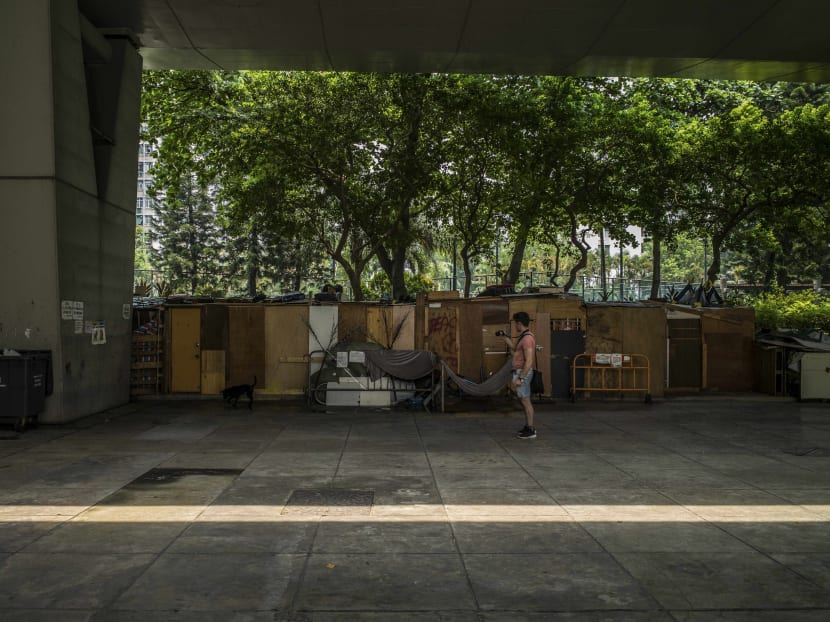Homelessness, poverty and injustice: Touring Hong Kong’s darker side
HONG KONG — Among the crowds on Kweilin Street in the run-down Hong Kong neighborhood of Sham Shui Po, Ms Alla Lau darted between street signs, peering at the backs of them until she found what she was looking for. She beckoned a group of tourists, mostly white, in flip-flops and with American accents.

A tourist taking photos of makeshift homeless shelters in Hong Kong's Sham Shui Po. Photo: The New York Times
HONG KONG — Among the crowds on Kweilin Street in the run-down Hong Kong neighborhood of Sham Shui Po, Ms Alla Lau darted between street signs, peering at the backs of them until she found what she was looking for. She beckoned a group of tourists, mostly white, in flip-flops and with American accents.
“There,” Ms Lau said, pointing to a handwritten white sticker in Chinese characters that referred to the grimy building across the street. It was an advertisement for one of Hong Kong’s notorious cage apartments, where, for as little as HK$1,200 a month (S$208), people could rent a cage to sleep in. The cages are stacked three deep and offer barely enough space to sit up in.
The group Ms Lau led had signed up for a tour of the less glamorous underbelly of this fabulously wealthy city. Over the course of three hours, tourists learnt about Hong Kong’s underpaid foreign domestic workers, its freewheeling street vendors and the suicides afflicting young students pressured by their parents to succeed in school.
Despite the horrid conditions in the cage apartments, Ms Lau said, they were not cheap. Per square foot, the monthly rent was more than that of the costlier apartments in Hong Kong, one of the world’s most expensive housing markets, and many people living in the cages make far less than the city’s monthly median income, roughly HK$12,000 a month.
During the eight or nine tours she leads a week, Ms Lau, 26, gathers people at the subway station in Mong Kok, a teeming area where there were clashes last summer when the police tried to crack down on street hawkers. Greeting tourists in a neon jacket and with a wide smile, she gives them brightly colored maps. A recent tour first seemed like any other as she directed her group past the street vendors selling goldfish in plastic bags.
But there was already an edge to the trip.
Shepherding the tourists past Filipino and Indonesian domestic servants, Ms Lau quietly told her group that these women were not covered by Hong Kong’s minimum wage; different, lower pay scales applied to them. Tourists calculated the amount into their local currencies and expressed surprise and dismay.
Mr Lau was inspired to become a tour guide in Hong Kong while backpacking around Europe; she took a tour of Sofia, Bulgaria, that highlighted the city’s darker side.
Determined to bring a similar experience to Hong Kong, she joined a tour company as a guide in her native city, but she was disappointed that the script she was given did not delve beneath the surface. She was not interested in telling tourists where to shop.
Ms Lau jumped ship to Hong Kong Free Tours when she was offered the chance to share with visitors the problems she and her friends faced, including the struggle to make ends meet.
“People come to Hong Kong for three or four days and see Tesla, Mercedes, skyscrapers in Central, all the things the government tries so hard to promote,” she said.
“If I am a tourist, I’d see those things, how expensive everything is here, and think, ‘Hong Kong people must have a really good life,’” she continued. “That’s just one side of Hong Kong and it isn’t telling a lot of people’s stories.”
As the tour wound deeper into Kowloon, the broad peninsula that points toward the sparkling towers of Hong Kong Island, Ms Lau discussed the city’s housing crisis. She stopped outside real estate agencies to explain the prices, instead of taking the group down the “sneaker street” favored by bargain-seeking tourists.
Ducking into the foyer of a landmark-listed building that houses a training school, Ms Lau talked about the intense pressure on students, which, she said, was partly to blame for the city’s youth suicide rate.
She led the group through ramshackle, makeshift shelters on Tung Chau Street, a homeless community on the edge of Sham Shui Po, first warning people not to take photos.
“This is their home,” she said.
When the three-hour walking tour ended, Ms Lau, still smiling, collected tips; the tours are free, but customers can choose to pay. Some disappeared back into Hong Kong’s subway system, where they could emerge 10 minutes later back in the heart of the island’s wealthy Central shopping district, with its air-conditioned Louis Vuitton and Armani stores. THE NEW YORK TIMES





